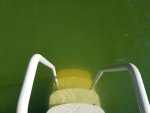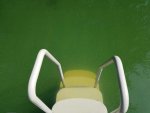No I have never used either. My understanding is that a flocculant just clumps dead algae up. To speed up removal. If I'm understanding it correctly--if you have a weak filter or pump or are inpatient you can use a flocculant to clump the dead algae together and then vacuum it to waste. I can not vacuum to waste. And I have a heck of a pump and great filtration. So If my understanding is correct then this would not help me. Am I wrong??
Close, but not quite right. Floc is not just for algae or the impatient

So a "floc" is a general term for a chemical compound that causes coagulation to occur (it's a bit more complicated than that but that simple definition will work). When fine matter is suspended in water, be it really small particles, dead algae, whatever, the surface of those particulates is generally negatively charged (think of it like static electricity, again a simple analogy but one that works). All of the particles are negatively charged and so they all repel one another. This is what keeps certain types of fine particulates suspended in water - static charge plus random collisions with molecules (Brownian motion). You can see this in water if you take a big scoop of soil, mix it with a few cups of water and then let it settle. All of the big particles and sand will immediately sink to the bottom, but the water will stay brown and murky for days and never really clear up. That's all of the suspended solid matter in the water. You can run it through a coffee filter, but even then, not all of the suspended matter will be filtered out.
What is a "floc"? A floc is a chemical compound that adds a polyvalent ion to the water. In the case of alum floc, the polyvalent ion is Al
3+. The polyvalent aluminum can come from aluminum trichloride (AlCl
3), aluminum sulfate (Al
2(SO
4)
3), or other aluminum type compounds. There are other flocs based on iron and other polyvalent metals, but adding iron to pool water is a bad idea.
So what does a floc do? The floc'ing chemical basically neutralizes the negative surface charge on the particles in suspension in the water. When the negative charge is removed, the particulates can start to coagulate into larger particulates which, when they reach a sufficient size, they will begin to sink to the bottom of the water column. Sometimes a floc requires an additional coagulating agent (usually a long changed polymer with charged end member groups) to help the particles "stick" together more, but many times the floc'ing agent itself is enough to cause the suspended solids to fall out of solution.
The term "floc" actually refers not to the chemical coagulant, but to the layer of fine sediment that is formed when the coagulated particulates settle at the bottom of the pool. It is that floc that you then vacuum (typically to waste) up and remove. You can vacuum a floc through the filter, but it is generally not the best way to remove a floc as it will cause the filter to load up and need cleaning. So flocculation is best practiced only when you have a "vacuum to waste" option.
So, for your water, I am wondering if you could obtain some floc and attempt to do a bucket test to see if anything settles out. From your previous pictures it looks like a standard white bucket doesn't give you much cloudiness and you only see the truly yellow nature of the water when you submerge your stairs. Even so, if you add the floc, you might see a darker layer of sediment form on the bottom of the bucket. Even if the test fails, it will tell us that we are not dealing with particulates causing your water coloration. If that is the case, then there is just some kind of chemical in your pool water (perhaps a very dilute, odd metal salt, such as manganese, that the testing was not done for) that is causing the coloration and chlorine will not remove it.






